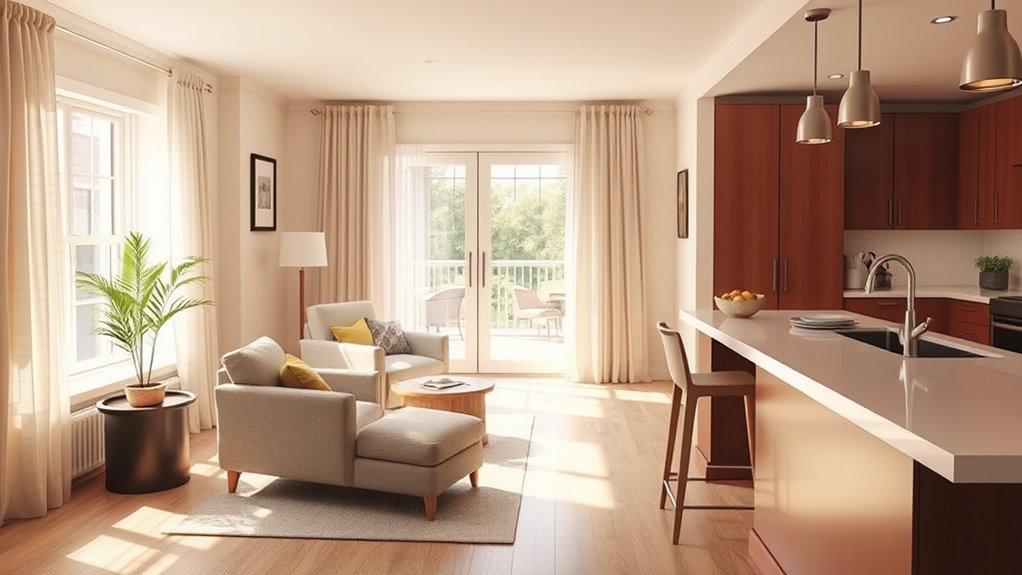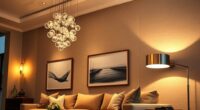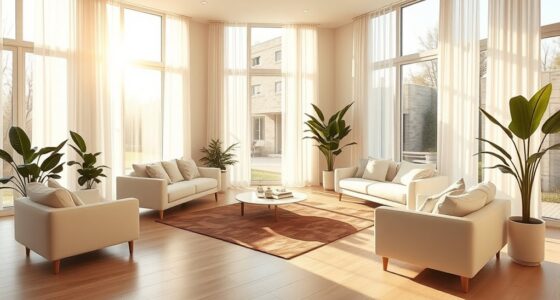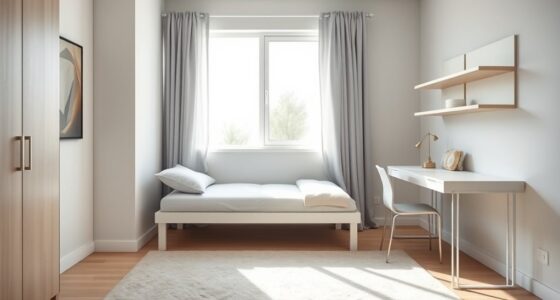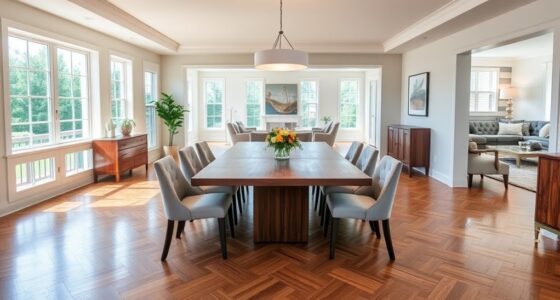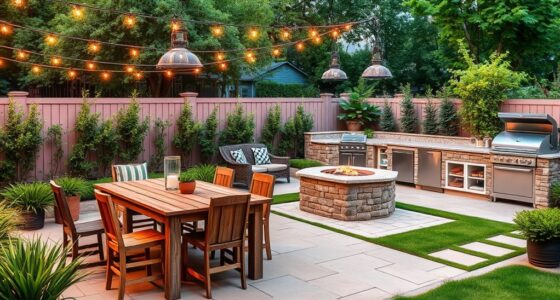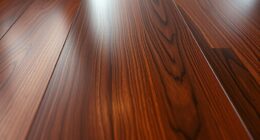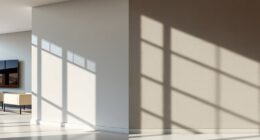To design your home for aging in place, focus on creating accessible layouts and applying universal design principles. Use wide doorways, open spaces, and non-slip flooring to guarantee easy movement and safety. Incorporate fixtures like lever handles and touch-activated lighting for convenience. Adjustable furniture and thoughtful placement of essentials support independence. Combining these features ensures your home remains comfortable and functional as your needs change, and exploring further will show you how to make it all work seamlessly.
Key Takeaways
- Incorporate wide doorways and open spaces to facilitate easy movement and wheelchair accessibility.
- Minimize thresholds and steps to reduce tripping hazards and ensure smooth transitions.
- Use non-slip flooring and proper lighting throughout for safety and visibility.
- Place frequently used items within reach to promote independence and reduce strain.
- Apply universal design features like lever handles and motion sensors for ease of use by all ages and abilities.
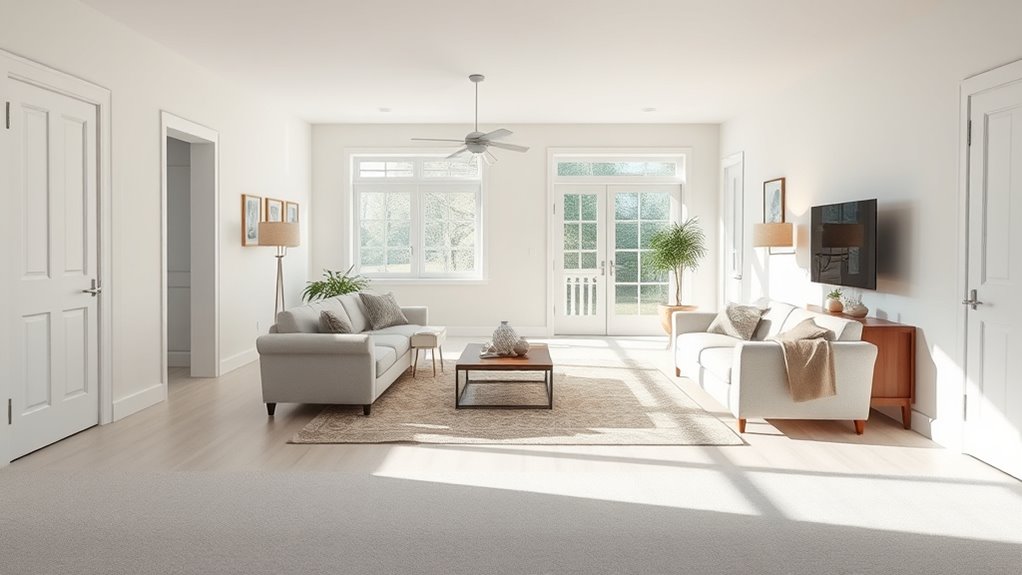
As the population ages, more people want to stay in their homes comfortably and safely for as long as possible. To make this a reality, designing with accessibility and universal design principles is essential. Smart home integration plays a crucial role here, allowing you to control lighting, climate, and security systems with simple commands or touch screens. These systems can be tailored to your needs, automatically adjusting to your routines or responding to voice commands, reducing the need for physical effort. This seamless tech integration not only enhances safety but also promotes independence, giving you confidence to manage daily tasks easily.
Equally important is choosing ergonomic furniture that supports your body’s changing needs. Instead of traditional furniture, opt for pieces designed with comfort and accessibility in mind. Ergonomic chairs with adjustable height and lumbar support make sitting and standing less strenuous, while beds with adjustable bases help you get in and out effortlessly. Using furniture that promotes proper posture reduces strain and minimizes the risk of falls or injuries. Incorporating these thoughtful choices into your home creates a space that adapts to your physical needs without sacrificing style or comfort.
When planning your layout, prioritize wide doorways and open spaces to facilitate easy movement and accommodate mobility aids like walkers or wheelchairs. Transitioning between rooms should be smooth, with minimal thresholds or steps that could pose tripping hazards. Placing frequently used items within easy reach reduces the need to stretch or bend, decreasing the likelihood of accidents. Incorporate non-slip flooring and ensure good lighting throughout the space to enhance visibility and safety. These adjustments create a more accessible environment that encourages you to move freely and confidently. Additionally, understanding accessible layouts can help you design a home that is both functional and inviting for everyone.
Universal design principles emphasize that your home should work for everyone, regardless of age or ability. This means selecting fixtures and finishes that are easy to operate, such as lever handles instead of knobs, and installing touch-activated or motion-sensor lighting. These features simplify daily routines and eliminate frustration, making your home more user-friendly. Combining smart home tech with ergonomic furniture and mindful layout choices ensures your home remains functional, safe, and welcoming as your needs evolve. Ultimately, thoughtful design empowers you to live independently and comfortably, enjoying your space for many years to come.
Frequently Asked Questions
How Can I Retrofit Existing Homes for Aging in Place?
You can retrofit your home for aging in place by installing grab bars, ramps, and non-slip flooring to enhance home safety. Widen doorways and hallways for easier mobility, and add lever handles instead of knobs. Reach out to community resources for assistance or financial support. These modifications make your home safer and more comfortable, allowing you to stay independent while reducing the risk of falls or accidents.
What Are Cost-Effective Solutions for Accessible Home Modifications?
A penny saved is a penny earned, and that’s true for accessible home modifications. You can find budget-friendly options like installing grab bars, non-slip mats, and lever-style door handles. DIY modifications, such as widening doorways or adding ramps, also cut costs. Focus on simple, practical upgrades that improve safety and accessibility without breaking the bank, making your home safer and more comfortable as you age in place.
How Do Lighting Designs Impact Safety for Seniors?
Good lighting safety enhances your safety by reducing trip hazards and ensuring clear pathways. Proper lighting design improves visual clarity, so you can easily see stairs, hallways, and obstacles. You should use bright, evenly distributed lights and avoid shadows or glare. Installing motion sensors or adjustable fixtures can adapt to your needs, helping you move confidently and safely throughout your home. Well-planned lighting is essential for preventing accidents and maintaining independence.
What Are the Best Materials for Slip-Resistant Flooring?
Think of slip-resistant flooring as a safety net beneath your feet. You want materials with non-slip textures that grip every step, like a gentle yet firm handshake. Opt for durable surfaces such as textured vinyl, rubber, or treated hardwood, which resist wear and provide reliable traction. These materials act as guardians, reducing falls and ensuring stability, so you can move confidently through your space without worry.
How Can Smart Technology Enhance Aging in Place?
A smart home and wearable technology can substantially enhance your aging in place by providing real-time health monitoring and safety alerts. With a smart home, you can control lighting, temperature, and security easily, reducing risks. Wearable devices track essential signs and detect falls, ensuring help arrives quickly. This integration promotes independence, peace of mind, and a safer living environment, making aging at home more manageable and comfortable.
Conclusion
By embracing accessible layouts and universal design, you’re crafting a sanctuary that adapts like a gentle river, flowing effortlessly through life’s changes. Think of your space as a welcoming hug, embracing everyone with open arms and ease. When you design with intention, you’re planting seeds of independence and comfort that blossom over time. Ultimately, your home becomes a timeless garden—beautiful, inclusive, and ready to nurture you through every chapter of life.
